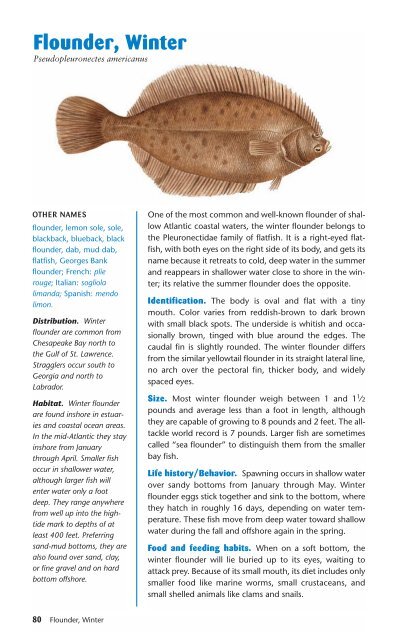Ken Schultz's Field Guide to Saltwater Fish - Macaw Pets store
Ken Schultz's Field Guide to Saltwater Fish - Macaw Pets store
Ken Schultz's Field Guide to Saltwater Fish - Macaw Pets store
You also want an ePaper? Increase the reach of your titles
YUMPU automatically turns print PDFs into web optimized ePapers that Google loves.
Flounder, Winter<br />
Pseudopleuronectes americanus<br />
OTHER NAMES<br />
flounder, lemon sole, sole,<br />
blackback, blueback, black<br />
flounder, dab, mud dab,<br />
flatfish, Georges Bank<br />
flounder; French: plie<br />
rouge; Italian: sogliola<br />
limanda; Spanish: mendo<br />
limon.<br />
Distribution. Winter<br />
flounder are common from<br />
Chesapeake Bay north <strong>to</strong><br />
the Gulf of St. Lawrence.<br />
Stragglers occur south <strong>to</strong><br />
Georgia and north <strong>to</strong><br />
Labrador.<br />
Habitat. Winter flounder<br />
are found inshore in estuaries<br />
and coastal ocean areas.<br />
In the mid-Atlantic they stay<br />
inshore from January<br />
through April. Smaller fish<br />
occur in shallower water,<br />
although larger fish will<br />
enter water only a foot<br />
deep. They range anywhere<br />
from well up in<strong>to</strong> the hightide<br />
mark <strong>to</strong> depths of at<br />
least 400 feet. Preferring<br />
sand-mud bot<strong>to</strong>ms, they are<br />
also found over sand, clay,<br />
or fine gravel and on hard<br />
bot<strong>to</strong>m offshore.<br />
80 Flounder, Winter<br />
One of the most common and well-known flounder of shallow<br />
Atlantic coastal waters, the winter flounder belongs <strong>to</strong><br />
the Pleuronectidae family of flatfish. It is a right-eyed flatfish,<br />
with both eyes on the right side of its body, and gets its<br />
name because it retreats <strong>to</strong> cold, deep water in the summer<br />
and reappears in shallower water close <strong>to</strong> shore in the winter;<br />
its relative the summer flounder does the opposite.<br />
Identification. The body is oval and flat with a tiny<br />
mouth. Color varies from reddish-brown <strong>to</strong> dark brown<br />
with small black spots. The underside is whitish and occasionally<br />
brown, tinged with blue around the edges. The<br />
caudal fin is slightly rounded. The winter flounder differs<br />
from the similar yellowtail flounder in its straight lateral line,<br />
no arch over the pec<strong>to</strong>ral fin, thicker body, and widely<br />
spaced eyes.<br />
Size. Most winter flounder weigh between 1 and 1 1 ⁄2<br />
pounds and average less than a foot in length, although<br />
they are capable of growing <strong>to</strong> 8 pounds and 2 feet. The alltackle<br />
world record is 7 pounds. Larger fish are sometimes<br />
called “sea flounder” <strong>to</strong> distinguish them from the smaller<br />
bay fish.<br />
Life his<strong>to</strong>ry/Behavior. Spawning occurs in shallow water<br />
over sandy bot<strong>to</strong>ms from January through May. Winter<br />
flounder eggs stick <strong>to</strong>gether and sink <strong>to</strong> the bot<strong>to</strong>m, where<br />
they hatch in roughly 16 days, depending on water temperature.<br />
These fish move from deep water <strong>to</strong>ward shallow<br />
water during the fall and offshore again in the spring.<br />
Food and feeding habits. When on a soft bot<strong>to</strong>m, the<br />
winter flounder will lie buried up <strong>to</strong> its eyes, waiting <strong>to</strong><br />
attack prey. Because of its small mouth, its diet includes only<br />
smaller food like marine worms, small crustaceans, and<br />
small shelled animals like clams and snails.


